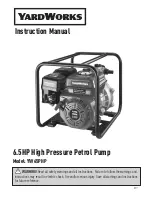
Piping:
All piping must be independently supported. No piping loads may be carried by the pump.
Piping should be the same size or larger than the pump connections.
Proper Piping to the suction is critical for proper pump operation.
-Suction pipe should be short and direct, with a minimum of fittings and turns.
-Suction pipe must continuously rise to the pump to avoid air pockets. All pipe connections must be air tight.
-If suction pipe is larger than the pump, an eccentric reducer must be used with the straight side on top to avoid an air
pocket.
-If suction of pump is above the liquid source level, a foot valve or other isolation valve will be needed to prime the pump.
A continuous stream of liquid must be made available for the pump suction to hold its prime.
-Do not use a suction valve for throttling the pump. This will cause loss of prime and damage to the pump that is not
covered by warranty.
-Be sure that the source liquid level is sufficient to prevent vortices from drawing air into the pump.
-Install a valve on the discharge line for use in regulating the pump flow and for isolating the pump during maintenance
and inspection.
Rotation:
The model FSP will operate properly only in one direction (clockwise when looking from the motor
end, counter-clockwise when viewed from the pump end).
Operating the pump in the reverse
rotation may cause the impeller to unscrew, breaking the shaft, damaging the pump and/or
the motor and voids the warranty
.
-Three phase motors can rotate in either direction. Single phase motors normally only rotate in the proper direction.
-To check rotation, you must observe the motor shaft or fan from the back of the motor. Remove the end cover from the
center of the back of the motor by prying off the cap. You do not need to remove any screws on most motors. Quickly
switch on and off the motor and watch the shaft rotation as it slows down. Motor shaft should be turning in the clockwise
direction when viewed from the back of the motor.
-If motor is turning in the wrong direction, have a qualified electrician interchange two of the three motor power wires.
This should reverse the rotation.
-Check the rotation again. If it is correct, replace the end cover cap.
Operation:
-Pump must be completely primed before starting. Air in the suction lines or case must be vented.
-
Do not operate the pump at or near zero flow
. At zero flow, heat will build up in the pump and can cause extreme
damage to the pump, property damage and/or possible injury to operating personal. Minimum flows of 10% of the
pumps best efficiency point are recommended unless otherwise authorized by ASP.
-
Do not operate the pump beyond the flow rates shown on published curves. Noisy pumps or the sounds of “pumping
rocks” may be signs of cavitation or operation beyond the pumps capacity.
-Check pump and motor for vibration. Vibration may be a sign of pipe strain, insufficient mounting or operation beyond
the pumps capacity.
Maintenance:
There is no scheduled maintenance required. Close-coupled pumps have no bearings. Bearings in the motors are
permanently grease lubricated and cannot be regreased. Mechanical seals will need to be replaced when leaking.
O-Rings may harden with age and may need to be replaced when they leak.
Motor Bearings and Pump Thrust:
-Open impellers generate significantly more thrust than do enclosed impellers. The Model F
SP with a 4.38” diameter
impeller operating at 20 psig generates about 150 pounds of thrust. The motor bearing carries this thrust load.
-The standard jet pump motor and the standard FSP motor uses as a front and rear bearing a size 203 grease lubricated
bearing. This bearing has a B10 rated life of approximately 6,000 hours when operated with a thrust load of 150 pounds
at 3500 RPM. This rating means that 10% of all bearings operated in this condition will fail within 6,000 hours of
operation. The average bearing life will be 3 to 4 times this 6,000 hours.
-Pumps and motors that operate intermittently, or only operate 40 hours per week, will usually have acceptable bearing
lives with the standard jet pump motor bearing. Pumps that operate continuously, 24 hours per day, will have about 10%
of their thrust bearings fail in the first year of operation.
-Pumps operating at 1750 rpm do not have these thrust limitations.
-For service applications that are critical, for installations that are difficult to access, for pumps operating at
differential pressures above 25 psig, or for open impellers larger than 4.38
” diameter, American Stainless
Pumps recommends that motors with larger thrust bearings and higher load ratings be used.
aspiomfspo 0415
Page 2 of 5























